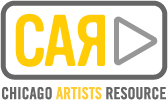I thought it might be a good idea to dedicate a blog post to giving some details about Kickstater.com, the micro-lending creative project fund-raising site I am using to make this project a reality. They do a great job of explaining why their system works, so I am copying some of the relevant Frequently Asked Questions that give a good impression of what they are about. While The Project for Art Accessibility does not have official non-profit status now, I hope to take that next step after this exhibition! That is why I am funding this as a "project," as kickstarter defines it--something with a clear beginning and end, and a set amount of funding as a goal. Here is some more about the site and why it works well for people with goals like mine:
"
What is Kickstarter?
Kickstarter is a new way to fund creative projects.
We believe that:
• A good idea, communicated well, can spread fast and wide.
• A large group of people can be a tremendous source of money and encouragement.
Kickstarter is powered by a unique all-or-nothing funding method where projects must be fully-funded or no money changes hands.
All-or-nothing funding?
Every Kickstarter project must be fully funded before its time expires or no money changes hands.
Why?
1. It allows people to test concepts (or conditionally sell stuff) without risk. If you don't receive the support you want, you're not compelled to follow through. This is huge!
2. It motivates. If people want to see a project come to life, they're going to spread the word.
Why do people support projects?
REWARDS! Project creators inspire people to open their wallets by offering smart, fun, and tangible rewards (products, benefits, and experiences).
STORIES! Kickstarter projects are efforts by real people to do something they love, something fun, or at least something of note. These stories unfold through blog posts, pics, and videos as people bring their ideas to life.
Who can fund their project on Kickstarter?
Kickstarter is focused on creative projects. We're a great way for artists, filmmakers, musicians, designers, writers, illustrators, explorers, curators, performers, and others to bring their projects, events, and dreams to life.
The word “project” is just as important as “creative” in defining what works on Kickstarter. A project is something finite with a clear beginning and end. Someone can be held accountable to the framework of a project — a project was either completed or it wasn’t — and there are definable expectations that everyone can agree to.
How do I pledge?
To pledge to a project, just click the green “Back This Project” button on any project page. You will be asked to input your pledge amount and select a reward. From there, you will go through the Amazon checkout process. Note that you must finish the Amazon checkout process for your pledge to be recorded.
If I make a pledge, when is my card charged?
If the project you’re backing is successfully funded, your card will be charged when the project reaches its funding deadline. If the project does not reach its funding goal, your card is never charged. That's why we call them pledges.
If funding does not succeed do backers pay anything?
Nothing. If funding fails, all pledges are canceled and that's that.
Are pledges tax deductible?
If a project creator has 501c3 status, then a pledge may be tax exempt. A project creator will likely tout their tax-exempt status if they have it.










